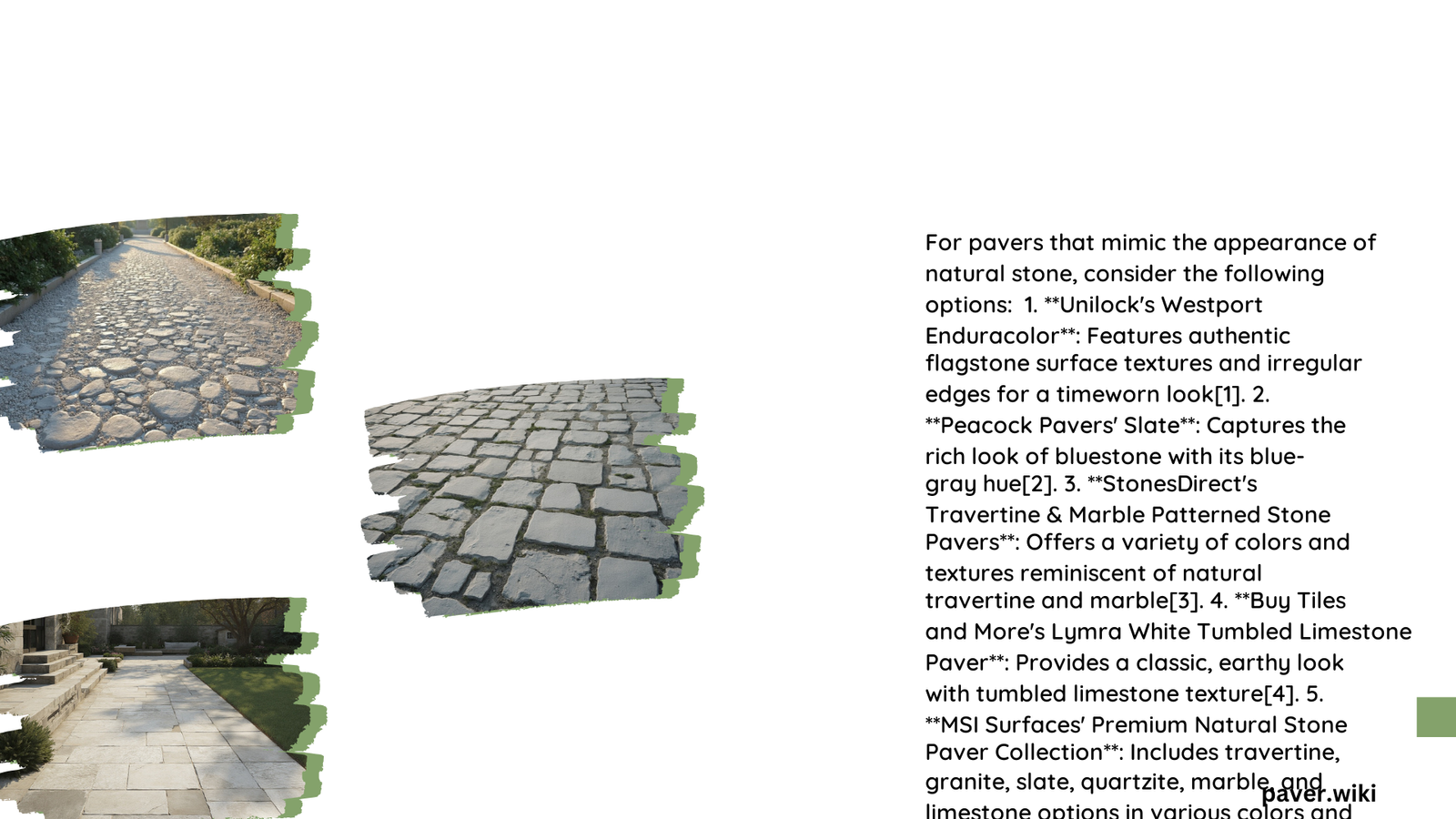Pavers that look like natural stone offer a cost-effective and low-maintenance alternative to genuine stone pavers. These manufactured options, typically made from concrete or porcelain, replicate the aesthetic appeal of natural stone while providing enhanced durability and easier installation. This guide explores the benefits, types, and considerations of choosing pavers that mimic natural stone for your outdoor spaces.
What Are the Different Types of Pavers That Look Like Natural Stone?
Several types of pavers are designed to emulate the appearance of natural stone:
- Concrete Pavers
- Porcelain Pavers
- Stamped Concrete Pavers
- Interlocking Pavers
Each type offers unique benefits and can be manufactured to resemble various natural stones such as:
- Granite
- Limestone
- Slate
- Travertine
- Sandstone
How Do Pavers That Look Like Natural Stone Compare to Genuine Stone?

Let’s compare the key aspects of manufactured stone-look pavers with natural stone pavers:
| Aspect | Pavers That Look Like Natural Stone | Natural Stone Pavers |
|---|---|---|
| Material | Concrete, porcelain, or other manufactured materials | Naturally occurring stone |
| Texture | Engineered to mimic natural stone | Authentic, unique textures |
| Durability | Varies (concrete: up to 2,500 PSI, porcelain: highly durable) | Highly durable (up to 8,000 PSI) |
| Cost | Generally more affordable | Often 2-5 times more expensive |
| Weight | Typically lighter (e.g., porcelain: 10-15 lbs/sq ft) | Heavier (20-30 lbs/sq ft or more) |
| Installation | Easier and faster | More time-consuming and labor-intensive |
| Maintenance | Often lower maintenance requirements | May require regular sealing and special care |
What Are the Benefits of Choosing Pavers That Look Like Natural Stone?
-
Cost-Effectiveness: Stone-look pavers are significantly more affordable than genuine natural stone, making them an attractive option for budget-conscious homeowners.
-
Ease of Installation: These pavers are typically easier and faster to install due to their uniform shapes and sizes, reducing labor costs and project timelines.
-
Durability: Many manufactured pavers offer excellent durability, with some options like porcelain pavers being highly resistant to weathering, staining, and fading.
-
Low Maintenance: Stone-look pavers often require less maintenance than natural stone. For example, porcelain pavers don’t need sealing and are easy to clean.
-
Consistency: While natural stone variations can be appealing, manufactured pavers offer more consistent colors and patterns, which can be advantageous for certain design aesthetics.
-
Lightweight: Some options, like porcelain pavers, are lighter than natural stone, making them easier to transport and install, especially in elevated or rooftop applications.
What Are the Maintenance Requirements for Pavers That Look Like Natural Stone?
Maintenance requirements vary depending on the type of paver:
- Concrete Pavers:
- Regular cleaning with mild detergent and water
- Sealing every few years to protect against moisture and staining
-
May require occasional re-sanding of joints
-
Porcelain Pavers:
- Simple cleaning with mild detergent and water
- No sealing required due to non-porous nature
-
Highly resistant to staining and fading
-
Stamped Concrete Pavers:
- Regular cleaning to prevent dirt buildup
- Resealing every 2-3 years to maintain color and protect against weathering
How Much Do Pavers That Look Like Natural Stone Cost?
The cost of stone-look pavers can vary widely based on factors such as material, quality, and region. Here’s a general price range:
- Concrete Pavers: $2 – $8 per square foot
- Porcelain Pavers: $3 – $15 per square foot
- Stamped Concrete: $8 – $20 per square foot
Installation costs typically range from $5 to $20 per square foot, depending on the complexity of the project and local labor rates.
What Factors Should Be Considered When Choosing Pavers That Look Like Natural Stone?
-
Intended Use: Consider the area where the pavers will be installed (e.g., patio, driveway, pool deck) and choose a material suitable for that application.
-
Climate: Some materials perform better in certain climates. For instance, porcelain pavers are excellent for freeze-thaw cycles.
-
Aesthetic Preferences: Choose a paver that best mimics the natural stone look you desire.
-
Maintenance Requirements: Consider how much time and effort you’re willing to invest in maintaining your pavers.
-
Budget: Factor in both initial costs and long-term maintenance expenses.
-
Installation Method: Some pavers may require specific installation techniques or substrates.
-
Durability Needs: If the area will experience heavy traffic or loads, choose a paver with appropriate strength ratings.
By carefully considering these factors, you can select pavers that look like natural stone that will enhance your outdoor space while meeting your practical needs and budget constraints.
References:
1. https://universalhardscapes.com/comparing-durability-concrete-pavers-vs-natural-stone/
2. https://tiletechpavers.com/blog/2023/04/28/4-key-differences-between-natural-stone-and-porcelain-pavers/
3. https://www.groundsource.pro/blog/walkways-interlocking-pavers-vs-natural-stone
